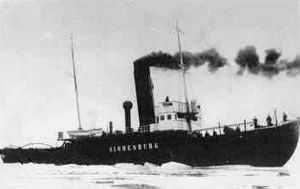Hindenburg (icebreaker)
 | |
| Career | |
|---|---|
| Name: | Hindenburg[1] |
| Owner: | Kooperative Kaufmannschaft Stettin[2] |
| Builder: | Stettiner Oderwerke[2] |
| Yard number: | 657[2] |
| Launched: | 15 December 1915[3] |
| Completed: | 23 December 1916[3] |
| Fate: | Sunk after mine explosion, 9 March 1918[3] |
| General characteristics | |
| Type: | Icebreaker[3] |
| Displacement: | 1,800 t (1,800 long tons)[2] |
| Length: | 51 m (167 ft 4 in)[2] |
| Beam: | 12.84 m (42 ft 2 in)[2] |
| Height: | 5.5 m (18 ft 1 in)[3] |
| Draught: | 5 m (16 ft 5 in)[2] |
| Decks: | 8[3] |
| Ice class: | 1[3] |
| Installed power: | 1,850 indicated horsepower (1,380 kW)[2] |
| Propulsion: | one three-cylinder triple expansion steam engine[3] |
| Crew: | 21[3] |
The German icebreaker Hindenburg was built by Stettiner Oderwerke at Stettin-Grabow in 1915 for the Cooperative Merchants' Guild of Stettin (German: Koop. Kaufmannschaft Stettin). The ship was launched on15 December 1915 but not completed until 23 December. In February 1918, the Hindenburg was part of Transportflotte I of the Sonderverband Ostsee operating against the Åland Islands. There the Hindenburg struck a mine off Eckerö on 9 March 1918 and sunk at 60°11′N 19°25′E / 60.183°N 19.417°ECoordinates: 60°11′N 19°25′E / 60.183°N 19.417°E. Three crew members died in the event.:[1]The wreck was found 1995 at 50 meters by diveinstructor Richard Johansson from Maltaproffsen and his crew from Ålands Dykcenter and FF-Dyk.
References
- Notes
- Bibliography
- Gröner, Erich (1989). Hafenbetriebsfahrzeuge (II: Bagger, Bergungs- und Tauchfahrzeuge, Eisbrecher, Schlepper, Verkehrsfahrzeuge), Yachten und Avisos, Landungsverbände (I). Die deutschen Kriegsschiffe, 1815-1945 VI (Koblenz: Bernard&Graefe). ISBN 3763748059.